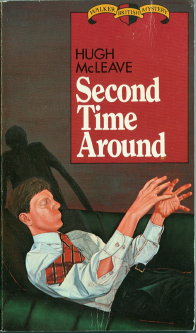HUGH McLEAVE – Second Time Around. Walker, US, hardcover, 1981; paperback, 1984. First published in the UK by Robert Hale, hardcover, 1981.

According to Al Hubin’s Crime Fiction IV, five of Hugh McLeave’s works of thriller fiction (one as by Richard Copeland) feature as their leading protagonist, free-wheeling psychologist Dr. Gregor Maclean, who, as a leading character in Second Time Around, takes on what is very nearly a secondary role.
On the other hand, a psychologist is exactly who is needed at the center of this Cold War tale about a reputable London publisher who on occasion checks into various clinics with no memory of who he is or why he is having such terrible dreams.
Maclean becomes interested when Dr. Armitage, a close acquaintance who was treating the man, gets run down by an automobile after confiding his concerns to Maclean, but in the stark, documentary-like style of writing that McLeave employs, Maclean seems to exhibit no great anguish over Armitage’s death – only the delight of tackling the puzzle it seems to supply.
Here’s a longish quote from pages 32-33 to illustrate. Deidre is Maclean’s long-suffering live-in assistant:
Had he followed Deidre’s advice he would have handed over the whole case to Scotland Yard; she considered his idea of investigating the case himself as mad and dangerous. Then, he always had this tussle with her; she sometimes felt inclined to view psychiatry as a painless exercise in straightening out mental kinks with homely advice and would have filled his working ours with nice, harmless neurotics, from compulsive handwashers and cake-eaters to to cat-and-bird phobias; Deidre had another criterion, sizing up if these patients could keep them in high-rent Harley Street; he, on the other hand, would have been involved with schizophrenics and paranoiacs, the acute depressive cases and hopeless alcoholics, seeing some bit of himself in all of them; most of them would touch him for money rather than expect to pay for his help. So, over the years, he and Deidre had established a sort of symbiosis; she allowed him a percentage of problem people with the sort of mental disorders that had brought him into psychiatry in the first place, while he treated her affluent neurotics.
“Macushla, just look at him as a patient,†he pleaded.
The case – and yes, he certainly does decide to get involved – takes Maclean, Deidre, the publisher’s daughter, and a male friend of the daughter, not to mention at least one other – on a hastily arranged trip to Germany, both East and West, on the trail of the man whose memory is either coming back — and if so, from what hidden past? Or he is cracking up completely and probably responsible for the deaths of several prostitutes who reminded him of whom?
Second Time Around verges very closely into science fictional territory, mixed in with a considerable amount of bitter cold war philosophy. But is the basis of the book based entirely on fiction? Very likely not.
Nor is this a book which is like anything I have ever read before. It is clear more quickly to the reader what the underlying circumstances are (which I am being so careful not to tell you about) than they are to Maclean. This may be an error, perhaps, on the author’s part, because the tale starts to plod a little, about two-thirds of the way through.
After reading this book I still prefer the more solid espionage efforts of Ross Thomas and Manning Coles, two writers who otherwise have little in common – or do they? – but I have to admit that, one, McLeave still has a small surprise or two up his sleeve, and, two, this very well may be one of the saddest love stories ever written. Is that enough for a recommendation? Either way, it will have to do.
